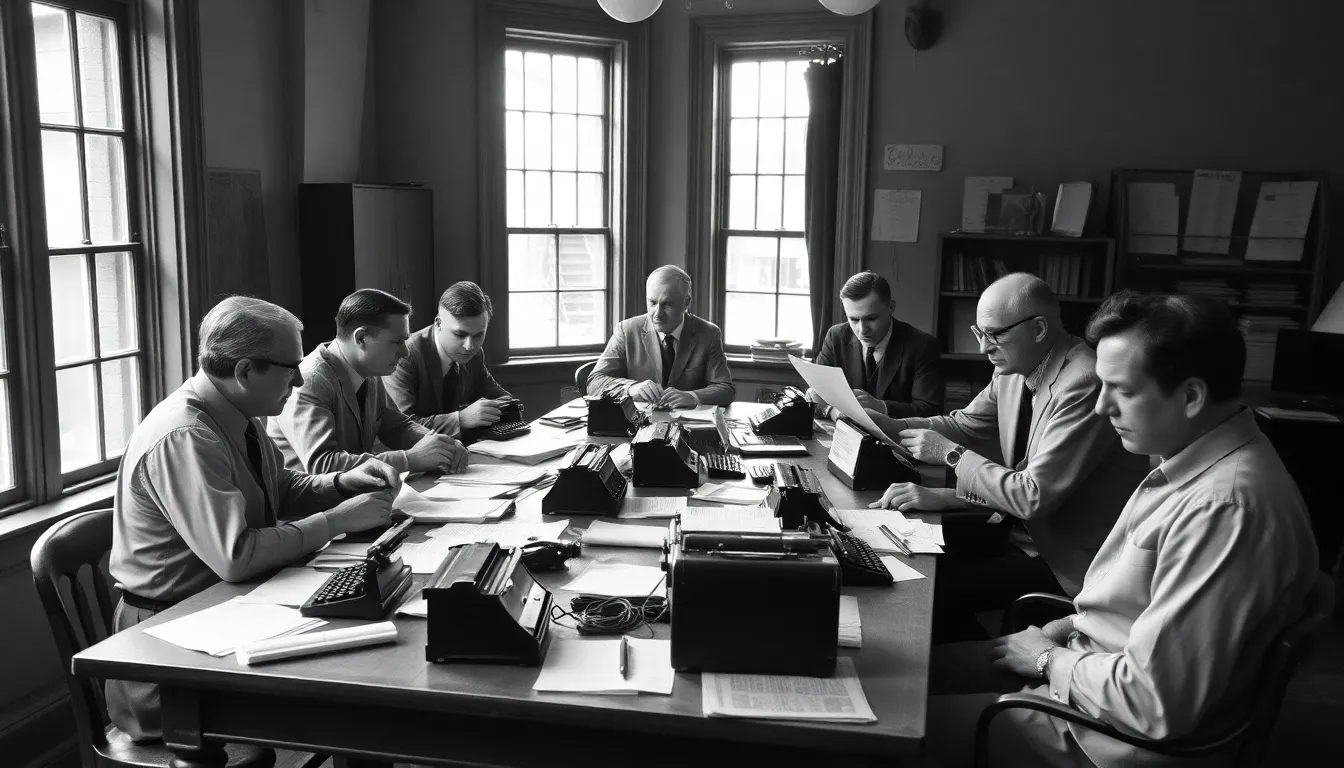In a world overflowing with headlines and clickbait, investigative magazine journalism stands as the unsung hero, diving deep into the stories that matter. It’s like the Sherlock Holmes of the media realm, unearthing hidden truths and exposing the secrets that those in power would rather keep buried. With a blend of tenacity and wit, these journalists don’t just report the news—they chase it down like a dog on a scent, bringing readers the juicy details that keep them coming back for more.
Imagine cracking open a magazine and finding not just fluff pieces but real, hard-hitting investigations that make you rethink everything you thought you knew. This isn’t just journalism; it’s storytelling at its finest, where every article is a thrilling ride through the twists and turns of human nature, corruption, and the quest for justice. Get ready to explore how investigative journalism shapes our understanding of the world one story at a time.
Table of Contents
ToggleOverview of Investigative Magazine Journalism
Investigative magazine journalism plays a crucial role in revealing significant stories often hidden from the public eye. This form of journalism combines in-depth reporting with a commitment to exposing truths.
Definition and Importance
Investigative magazine journalism focuses on comprehensive investigations into complex issues, often uncovering malfeasance and societal problems. By holding powerful entities accountable, it fosters transparency and promotes social justice. This type of journalism contributes to informed public discourse, as it challenges readers to engage with critical topics. Notable examples, such as the Watergate scandal reporting, illustrate its impact on political landscapes and public awareness. Investigative stories frequently provide deeper insights into human psychology, corruption, and ethical dilemmas, encouraging readers to question the status quo.
Key Features
Key features of investigative magazine journalism include extensive research and rigorous fact-checking. Journalists often spend months or years on a single story, utilizing various methods like interviews, public records, and data analysis. High-quality narratives emerge from these investigations, drawing readers into complex issues. Storytelling techniques enhance engagement, making intricate subjects more accessible and relatable. Visual elements, such as photographs and infographics, support compelling narratives. Furthermore, investigative pieces typically emphasize accountability, prompting discussions around policy changes and societal impacts. This unique blend of journalism not only informs but inspires action in both individuals and communities.
Historical Context

Investigative magazine journalism has deep roots in the pursuit of truth and accountability. The origins of this vital reporting style trace back to the late 19th century.
Origins of Investigative Journalism
The rise of investigative journalism gained momentum in response to societal issues. Muckrakers, such as Ida B. Wells and Upton Sinclair, played critical roles in exposing corruption and injustices. Their bold reporting highlighted labor exploitation, racial discrimination, and political corruption. This journalism aimed to inform the public, provoke reform, and challenge powerful institutions. By providing a voice to the marginalized, these early journalists laid the groundwork for modern investigative work.
Evolution Over Time
Over decades, investigative journalism evolved alongside technological advancements. The introduction of the internet transformed how stories were researched and disseminated. New tools for data analysis and communication facilitated deeper investigations and larger audiences. Notably, renowned publications like The New York Times and The Washington Post began to integrate investigative reporting as a core element of their publications. The impact of major events, including the Watergate scandal, solidified the importance of investigative work, influencing both public policy and journalism itself. This evolution reflects an enduring commitment to exposing truth and promoting transparency in society.
Prominent Investigative Magazine Journalists
Investigative magazine journalism features several key figures who have made significant contributions to the field. These journalists play a crucial role in uncovering hidden truths and promoting transparency.
Notable Figures
Ida B. Wells stands out as a pioneering journalist who boldly reported on racial injustice in the late 19th century. Upton Sinclair exposed the horrors of the meatpacking industry with his seminal work, “The Jungle.” Seymour Hersh gained recognition for his investigation into the My Lai Massacre during the Vietnam War. Jane Mayer has critically examined political corruption and its systemic issues in her work for The New Yorker. These individuals exemplify the impact of fearless reporting in driving social change.
Their Impact on Journalism
These prominent journalists shaped the landscape of investigative reporting. Wells’s commitment to justice inspired future generations to challenge societal norms. Sinclair’s revelations not only prompted regulatory reforms but also sparked public outrage. Hersh demonstrated how investigative work can alter public perception and policy, especially during times of political turmoil. Mayer’s meticulous research emphasizes the necessity of accountability in government. Together, their contributions underline the importance of investigative journalism in fostering informed public discourse and promoting change.
Challenges in Investigative Magazine Journalism
Investigative magazine journalism faces several significant challenges that impact reporting accuracy and effectiveness.
Ethical Dilemmas
Ethical dilemmas frequently arise during investigations. Journalists often navigate between the public’s right to know and respecting privacy boundaries. Situations involving whistleblowers introduce complex issues, as revealing identities could place individuals in danger. Truthful reporting demands a balance, where potential harm to subjects must be weighed against the importance of the story. Prioritizing ethical considerations ensures that journalists maintain integrity while pursuing stories of public interest. Moreover, determining how to handle sensitive information remains an ever-present challenge, prompting careful deliberation in the investigative process.
Financial Constraints
Financial constraints heavily influence investigative journalism’s capacity to operate effectively. Budget cuts at major publications often reduce the number of reporters available for in-depth assignments. Limited resources hinder comprehensive research, impacting the once-standard practice of extensive fact-checking. Journalists increasingly rely on grant funding and donations to support their work, which can compromise editorial independence. Additionally, commercial pressures may lead to prioritizing click-driven content over rigorous investigative work. Sustaining quality journalism amidst financial challenges demands innovative solutions and strong community support.
Techniques and Methods
Investigative magazine journalism employs various techniques and methods to uncover the truth. These strategies ensure thoroughness and clarity in storytelling.
Research Strategies
Research strategies play a crucial role in investigative journalism. Journalists often begin by gathering data from public records, court documents, and financial statements. Using open-source intelligence tools, reporters can access a wealth of information online, revealing hidden connections. Collaborating with experts in specific fields enhances the depth of research and analysis. Journalists frequently rely on investigative databases and archives to ensure accuracy in their findings. Additionally, many use social media platforms to track real-time updates and public reactions related to investigations.
Interviewing Techniques
Effective interviewing techniques significantly impact the quality of investigative journalism. Reporters typically approach interviews with a clear purpose, formulating open-ended questions that encourage dialogue. Establishing rapport with sources fosters trust, which can lead to more candid responses. Recording interviews, where legally permissible, allows for greater accuracy in quotations. Investigative journalists often employ silence strategically, enabling sources to elaborate on their thoughts and experiences. Following up on initial conversations with further questions can uncover additional layers of information essential to the story.
Investigative magazine journalism remains a cornerstone of democracy and accountability. Its commitment to uncovering truths and challenging power structures is more vital than ever. As journalists navigate ethical dilemmas and financial constraints, their innovative techniques and relentless pursuit of stories continue to inspire public discourse and drive social change.
The legacy of trailblazers like Ida B. Wells and Upton Sinclair serves as a reminder of the transformative power of investigative reporting. By fostering transparency and encouraging informed discussions, this form of journalism not only informs the public but also empowers individuals to advocate for justice and accountability. As society evolves, the importance of investigative journalism in shaping perceptions and influencing policy will undoubtedly endure.





